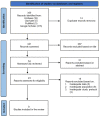The Utility of Novel pH-Impedance Monitoring Parameters (PSPW Index and MNBI) in Pediatric Gastroesophageal Reflux Disease Phenotypes-A Systematic Review
- PMID: 38893061
- PMCID: PMC11172627
- DOI: 10.3390/jcm13113351
The Utility of Novel pH-Impedance Monitoring Parameters (PSPW Index and MNBI) in Pediatric Gastroesophageal Reflux Disease Phenotypes-A Systematic Review
Abstract
Background/Objectives: Researchers have proposed two novel impedance-pH parameters, mean nocturnal baseline impedance (MNBI) and the post-reflux swallow-induced peristaltic wave (PSPW) index, to enhance the diagnosis of gastroesophageal reflux disease (GERD) and enable better predictions of the effectiveness of anti-reflux therapies. This systematic review aims to synthesize the available evidence on the utility of the PSPW index and MNBI as diagnostic tools for pediatric GERD. Methods: A systematic search of studies reporting PSPW index and MNBI values in patients with GERD was performed in PubMed, Embase, Clarivate, Scopus, Cochrane and Google Scholar databases from their beginning until April 2024. The following terms were used: GERD, children, pediatric, PSPW and MNBI. Results: Eight studies were included, describing 479 patients ranging from 2 months to 17 years old over an 8-year period in 12 pediatric centers. Four studies demonstrated that children with pathological acid exposure have a significantly lower MNBI, with a good discriminatory ability to diagnose GERD. The PSPW index showed lower values in patients with reflux hypersensitivity (RH) compared to those with functional heartburn (FH). Conclusions: Patients with pathological acid exposure tend to exhibit lower MNBI and PSPW index values compared to those with normal acid exposure. MNBI and the PSPW index show promise as diagnostic tools in distinguishing between different GERD phenotypes. Further research is needed to establish standardized diagnostic criteria and optimize the clinical applicability in GERD diagnosis and management.
Keywords: GERD; MNBI; PSPW; pediatric.
Conflict of interest statement
The authors declare no conflicts of interest.
Figures
References
-
- Rosen R., Vandenplas Y., Singendonk M., Cabana M., DiLorenzo C., Gottrand F., Gupta S., Langendam M., Staiano A., Thapar N., et al. Pediatric Gastroesophageal Reflux Clinical Practice Guidelines: Joint Recommendations of the North American Society for Pediatric Gastroenterology, Hepatology, and Nutrition and the European Society for Pediatric Gastroenterology, Hepatology, and Nutrition. J. Pediatr. Gastroenterol. Nutr. 2018;66:516–554. doi: 10.1097/MPG.0000000000001889. - DOI - PMC - PubMed
-
- Hojsak I., Ivković L., Trbojević T., Pavić I., Jadrešin O., Mišak Z., Kolaček S. The Role of Combined 24-h Multichannel Intraluminal Impedance-PH Monitoring in the Evaluation of Children with Gastrointestinal Symptoms Suggesting Gastro-Esophageal Reflux Disease. Neurogastroenterol. Motil. 2016;28:1488–1493. doi: 10.1111/nmo.12846. - DOI - PubMed
-
- Pilic D., Fröhlich T., Nöh F., Pappas A., Schmidt-Choudhury A., Köhler H., Skopnik H., Wenzl T.G. Detection of Gastroesophageal Reflux in Children Using Combined Multichannel Intraluminal Impedance and PH Measurement: Data from the German Pediatric Impedance Group. J. Pediatr. 2011;158:650–654.e1. doi: 10.1016/j.jpeds.2010.09.033. - DOI - PubMed
Publication types
LinkOut - more resources
Full Text Sources
Miscellaneous


